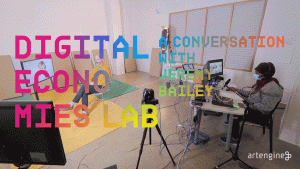In this conversation, Famous New Media Artist Jeremy Bailey shares his insights on the wave of interest in Non-Fungible Tokens (NFTs). To Bailey, they are nothing new. Artists have challenged themselves to trace authorship digitally many times before, so why then is the conversation breaking ground in the popular sphere today? To understand this, Bailey walks us through the history of New Media and the monetization of art. Furthermore, Bailey calls out the funny history of writing art into canons. It’s a chicken and the egg conundrum; does art, in all its mediums, need to be written about to be viewed as art? Bailey describes the internet economy as a graveyard for artistic labour and challenges us to consider how NFTs can play a role in dismantling this practice of viewing new media art as tertiary to ‘fine’ art and creative labour. Drawing links between the impacts of the Portapak and this moment of NFTs, Bailey leaves us wanting to explore the many modes of digital resistance countering the abuse of creative digital labour, including his recent project YOUar.shop.
More about Jeremy Bailey
https://www.jeremybailey.net/
https://youar.shop/
https://www.leanartist.org/
http://www.goodpointpodcast.com/
If you are unfamiliar with NFTs, here are some links for you to check out.
Read Paul J Ennis at The Conversation for a quick review of the NFT in the context of the burning Banksy.
Rhizome has helpfully outlined a number of artist projects around monetization in the digital realm that predate the hype othe NFT, including Bailey’s YouAR that we discuss in the conversation above.
ArtNet News considers what we can learn about the NFT hype from the Comic Book bubble of the 1980s and 90s.
Go deeper with Why we need a feminist manifesto for the blockchain on HyperAllergic.
An interesting data analysis of sales and fees in NFT here.
Some NFT AND Other Projects Mentioned in conversation
Feral File/Casey Reas, in partnership with Bitmark – https://feralfile.com/
Folia/Billy Rennekamp – https://www.folia.app/
hic et nunc or H=N network – https://www.hicetnunc.xyz/
https://foundation.app/
https://niftygateway.com/ (The one the Winklevoss twins are involved in)
Rally: an open network that enables creators to launch independent economies powered by blockchain ethereum – https://rally.io/
Other tools discussed
https://openframeworks.cc/ (toolkit designed for creative coding, founded by Zach Lieberman, Theo Watson and Arturo Castro)
https://www.processing.org/ (creative coding tool started by Ben Fry and Casey Reas)
https://p5js.org/ (created by Lauren Lee McCarthy)
Collaborators mentioned
https://www.newrafael.com/ (Rafaël Rozendaal)
https://foundation.app/@newrafael (Rafaël Rozendaal)
https://billyrennekamp.com/ (Billy Rennekamp)
Produced by the Artengine Stream Team:
Mikki Gordon aka Seiiizi https://twitter.com/s3iiizi
Ryan Stec
Kimberly Sunstrum https://www.kmbrlysnstrm.com/
Editorial Assistant
Erin Galt
Production Design Consultation
Leslie Marshall/MAVNetwork http://www.mavnetwork.com/
Post-Production Support: Chris Ikonomopoulos
DEL Theme Music by Mikki Gordon aka Seiiizi
Artengine’s Digital Economies Lab brought together a diverse group of artists, designers and other creatives to rethink the infrastructure of cultural production in the 21st century.
Funding for the Digital Economies Lab was received through the Canada Council for the Arts Digital Strategies Fund.
“We have to participate. You have to be a co-owner of this future.”

Famous New Media Artist Jeremy Bailey helped shape the structure of the Digital Economies Lab and here we discuss their vision for artistic prosperity in the 21st century. We chat about artists’ complicated relationship to capital and how we are in an exciting moment of transformation. Join us, as we delve into questions of value, the pace of production, and our perception of reality, augmented or not.

Western thought has long assumed a special relationship between vision and knowledge: Seeing is believing. But what about the traffic between sonic experience and ideas? How do inherited beliefs abo(…)